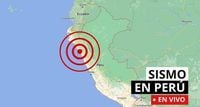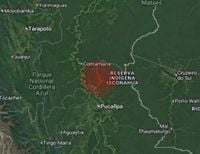Peru, a country known for its breathtaking landscapes and rich cultural heritage, found itself once more reminded of the ever-present power of nature in early October 2025. According to official reports from the Instituto Geofísico del Perú (IGP), three moderate earthquakes struck different regions of the nation within just 24 hours, stirring both public concern and a renewed focus on preparedness.
The most significant of these tremors occurred on October 9, 2025, at precisely 08:42 a.m. local time. The National Seismological Center of Peru (IGP) reported that the earthquake registered a magnitude of 4.5 on the Richter scale. Its epicenter was pinpointed 64 kilometers southeast of Contamana, straddling the border between the Ucayali and Loreto regions. With a depth of 162 kilometers, the quake was felt in Contamana at an intensity of II-III—enough for residents to notice a gentle swaying, but thankfully, not enough to cause injuries or material damage. As the IGP noted, the considerable depth of the event played a crucial role in mitigating its impact on the surface.
But this wasn’t the only seismic activity that kept Peruvians on alert. Just a few hours earlier, at 05:05 a.m. on the same day, a magnitude 3.7 earthquake was recorded 21 kilometers northwest of Zorritos, in the Contralmirante Villar province of the Tumbes region. This quake, occurring at a shallower depth of 22 kilometers, was also felt with an intensity of II-III in Zorritos. According to El Comercio, no injuries or significant damage were reported here either, but the event served as a wake-up call for residents in the area.
The sequence of tremors began the previous evening, on October 8, 2025, when a magnitude 4.1 earthquake struck 74 kilometers west of Pastaza, in the Loreto region. The quake, at a depth of 114 kilometers, did not result in casualties or destruction, but underscored the nation’s vulnerability to seismic activity. The IGP’s continuous monitoring and timely alerts proved essential in keeping the public informed and safe.
Why does Peru seem to dance so frequently to the rhythm of the earth? The answer lies beneath the surface. Peru is perched on the western edge of South America, squarely within the infamous Pacific Ring of Fire—a massive horseshoe-shaped zone that stretches about 40,000 kilometers and is responsible for more than 80% of the world’s earthquakes. As Hernando Tavera, the president of the IGP, explained to RPP Noticias, “Peru’s seismic activity is due to the collision or convergence of the Nazca Plate with the South American Plate. This process is practically a scenario of frontal collision between two plates.”
History offers sobering reminders of the region’s seismic potential. The largest instrumentally recorded earthquake in Peru struck on October 3, 1974, with a magnitude of 8.0 in Lima. That quake lasted about 90 seconds, claimed 252 lives, and left 3,600 injured. While the recent tremors were far less devastating, their frequency is a stark reminder that the risk is ever-present.
For those unfamiliar with seismic terminology, it’s worth noting that the words "sismo," "temblor," and "terremoto" all essentially mean the same thing: the sudden shaking of the ground caused by seismic waves. As Tavera clarified, “The use of these terms is more a matter of tradition in each population or country. In Peru, we call it an earthquake when it causes human losses and material damage, and a tremor when it just shakes the ground and nothing happens.”
But what exactly happens during an earthquake? Tavera elaborated, “Elastic waves are what propagate and shake the ground, and that is the perception we receive or have when an earthquake occurs. In general terms, it is the sudden shaking of the ground due to the passage of seismic or elastic waves generated by a rupture in rocks beneath the subsurface.”
One common misconception is that a series of small tremors can prevent a larger, more destructive earthquake by releasing built-up energy. However, the IGP and other specialists have debunked this myth, confirming that minor quakes do not necessarily reduce the risk of a major event.
Given these realities, both authorities and experts stress the importance of cultivating a culture of prevention. The National Institute of Civil Defense (Indeci) and the IGP regularly organize earthquake drills in homes, workplaces, and schools. Participation in these drills is not just recommended—it’s vital. As the IGP reminded the public, “It is our responsibility to participate and take earthquake drills seriously.”
Practical advice for earthquake preparedness abounds. Before a quake strikes, families are urged to identify safe zones both inside and outside their homes, prepare an emergency backpack with essentials like water, non-perishable food, a flashlight, a battery-powered radio, a first aid kit, and a blanket. Heavy objects and tall furniture should be secured to prevent them from toppling, and escape routes must be kept clear at all times.
During a quake, the golden rule is to stay calm and move to a safe area, away from windows, mirrors, and heavy furniture. If unable to exit, individuals should cover their heads and necks and seek shelter under a sturdy table or next to a pillar. If in a vehicle, it’s best to pull over and stop in a safe spot, far from buildings or power lines. And, as emphasized by El Comercio, “Never use elevators during an earthquake, as they could detach from their structure and fall from a great height with people inside.”
After the shaking stops, it’s important to check for structural damage and inspect gas, water, and electrical systems. Use a flashlight instead of candles or matches, and head to designated safe zones through established evacuation routes. If trapped, signaling with a flashlight or whistle can help rescuers locate you. Those near the coast should move inland until the risk of a tsunami is ruled out.
Emergency preparedness extends beyond the individual. The IGP and civil defense authorities provide critical information through official channels and social media. Emergency numbers such as 105 for general emergencies and police, 116 for firefighters, and 106 for ambulance services are vital lifelines in times of crisis.
For families, the so-called “Survival Combo” is recommended: an emergency backpack for the first 24 hours and a reserve box with supplies for the following days. These should be tailored to the family’s needs, including considerations for children, the elderly, pregnant women, or those with chronic illnesses. The key is accessibility and readiness—any sturdy bag or box will do.
Ultimately, the recent tremors in Ucayali, Loreto, and Tumbes serve as a powerful reminder that seismic risk is an inescapable part of life in Peru. While the earth’s movements are beyond human control, preparedness, vigilance, and community cooperation can make all the difference when nature decides to shake things up.


